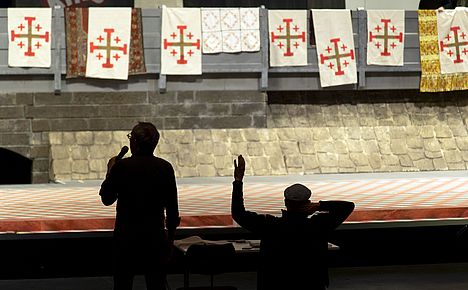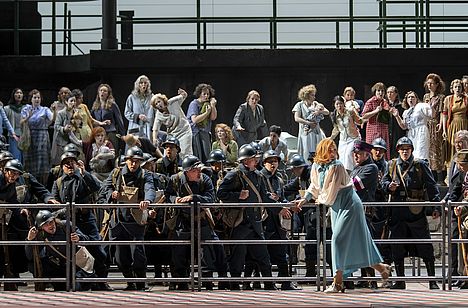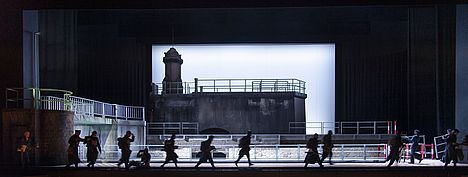


Lohengrin
»Once upon a time there was a king who died and left behind two children, a son and a daughter. However, the daughter was one year older than the son…«
With Lohengrin, Richard Wagner created, following The Flying Dutchman and Tannhäuser, the last of his three great romantic operas. In the forced, resigned retreat of the hero at the end of this work, the author anticipated his own exile: His participation in the Dresden May Uprisings of 1849 cost him his position as Royal Saxon Court Kapellmeister and made him a political refugee. Safe from prosecution in Zurich, Wagner entered a long latency phase of art-philosophical speculation, during which the conception of the Nibelung Tetralogy matured within him; with it, he consciously bid farewell to the opera theater of his time. The premiere of his "last opera," fragments of which he had presented in concert in Dresden in 1848, was enabled and curated by his friend Franz Liszt in Weimar in 1850 – in the absence of the author, who was under police search. While the premiere met more with perplexity and criticism than understanding, in the last quarter of the 19th century, this very opera, with its abundance of melodies and martiality, became the decisive engine for the composer's breakthrough with wider audiences.
Wagner's Lohengrin, the pinnacle of artistic Romanticism, simultaneously allows a glimpse into the abyss of political Romanticism: The narcissism of an entire nation reflected in the ideal image of the mysterious Swan Knight, who rushes to aid a distressed maiden and strengthens the unity and defensibility of the realm against internal and external enemies; whose mission fails because the rescued maiden cannot meet the demand of his love, which requires unquestioning devotion, and is seized by doubt about his purity and unquestionability; who withdraws – misunderstood – from the world of humans into the high air of his tragic loneliness. Wagner has created here a projection surface in which ruler and leader figures from Ludwig II to Adolf Hitler believed they recognized themselves, and whose aura at the same time seeks to mythically glorify the role models of the patriarchal bourgeois marriage.
No other work of Wagner's has experienced as much devout devotion and endured as much critical ridicule as Lohengrin. One thing is clear: Given the aporias of this work, the theater is extremely challenged to unfold a consistent insistent and sensitively immanent deconstruction of its role models and conflict structures. Only the culture of doubt, personified in the form of the pagan witch Ortrud, demonized and tabooed within the play itself, is appropriate today for the epoch-making and at the same time deeply questionable art of Richard Wagner.
The "amplifying, realizing, and precision of the mythically distant" – quite in the sense of the Thomas Mann quoted here – are design strategies measured by the theatrical art of Wieler, Morabito, and Viebrock: Psychology and modern narrative art combine with legend and myth, in an attitude that unites love for tradition and doubt about it. They have descended into the fairy-tale and mythological mycelium to which Wagner's eclectic Lohengrin myth connects. In doing so, they stumbled upon a fairy tale that begins like this:
"Once upon a time there was a king who died and left behind two children, a son and a daughter. The daughter, however, was a year older than the son. And one day, the two royal children argued with each other about which of them should become king, for the brother said: 'I am a prince, and when princes are present, princesses do not come to power.' But the daughter countered: 'I am the firstborn and the eldest, the precedence belongs to me.'"
This tale has been documented in countless variations by folklore research. Most often, the rivalry leads to the brother murdering his sister; however, in some cases, it is the older sister who rebels against the patriarchal line of succession by murdering her younger brother. This suppressed and repressed conflict triggers the events of the opera: Elsa is the firstborn daughter of the Duke of Brabant, but as a woman, she is excluded from the succession in favor of her younger brother Gottfried. Additionally, she is to be forcibly married to her guardian Telramund for reasons of maintaining patriarchal power. There are thus enough good or bad reasons for her to liberate herself from the humiliating gender role assigned to her through an act of violence. That it is a deeply ambivalent sibling love, oscillating between love and hate, that generates Wagner's Lohengrin narrative was first crystallized by Freud's pupil Otto Rank in a psychoanalytic reading in 1911.
Let's not forget: In the first scenes of the opera, efforts are made to clarify the mysterious disappearance of the heir to the throne, Gottfried; a criminal procedure is initiated against the presumed fratricide. By the end of the day, the vanished brother is forgotten, no longer inquired about. His absence is overshadowed by the appearance of a savior, Lohengrin, who outshines all and everything: Lohengrin. This forgetfulness might be explainable in all characters—
except for Elsa. Who, if not she—as the closest relative of the missing child—should continue to ask, to investigate, especially now, after her innocence has been proven by divine judgment? There is only one answer: It is in her interest that he remains missing and forgotten. For she benefits from his disappearance.
The famous prohibition "Never shall you ask me..." also represents a clever feint: With great fanfare, a mystery is introduced to us, so that we wear ourselves out trying to solve it and forget to ask the other, much more obvious question: namely, the whereabouts of the heir to the throne. The fantasy and surrogate figure created by Elsa and projected into reality both contains and symbolizes the repressed brother, for Lohengrin is the simulacrum of Gottfried. A simulacrum is a real or imagined thing that is related to or resembles something or someone else: Lohengrin is Gottfried's image, likeness, mirror image, dream image, idol, and illusion. It is no coincidence that one must disappear before the other can appear—and vice versa. And it is no coincidence that the "shining silver armor" of the Swan Knight mirrors the "shining silver garment" in which Gottfried reappears at the end of the opera, in a literal and metaphorical sense. Yet unlike with the brother, with Lohengrin a marriage and in it a division of powers is possible and permissible—as Elsa at least hopes.